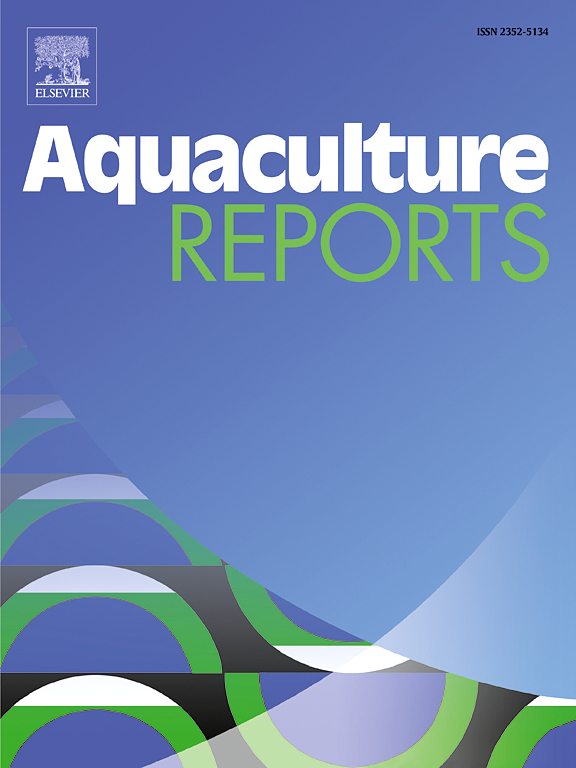Effect of temperature on the digestibility of non-starch polysaccharide-rich ingredients in Nile tilapia (Oreochromis niloticus)
IF 3.2
2区 农林科学
Q1 FISHERIES
引用次数: 0
Abstract
This study aimed to investigate the interaction effect of NSP-rich ingredient and rearing temperature on nutrient digestibility of the ingredients in Nile tilapia. Seven NSP-rich ingredients were tested: insect meal, wheat bran, palm kernel meal, rapeseed meal, sunflower meal, dried distillers grains with solubles (DDGS) from corn, and rice bran. A balanced control diet was formulated followed by the formulation of seven test diets by mixing 30 % of each test ingredient with 70 % of the control diet and fed to fish reared at 24 or 32 °C. At each temperature, 35 all male Nile tilapia with an initial mean weight of 45.0 g at 24 °C and 43.8 g at 32 °C were housed in each of 24 glass-tanks, each containing 60 L of water. The diets were administered to the fish groups in triplicate over 42 d in a recirculating aquaculture system. Fecal samples were collected and analyzed alongside the diets to determine nutrient digestibility. Digestibility of all nutrients differed between ingredients (P < 0.001) at both temperatures. Wheat bran had the lowest NSP digestibility at both 24 (1.9 %) and 32 °C (9.7 %). At 24 °C, DDGS showed the highest NSP and protein digestibility (41.4 and 90.3 %), while at 32 °C insect meal showed the highest NSP and fat digestibility (59.8 and 97.5 %). Insect meal showed the highest fat digestibility (97.4 %) also at 24 °C. An interaction effect between ingredient and temperature was observed for the digestibility of NSP, carbohydrate, protein, amino acids, magnesium, and dry matter (P ≤ 0.035). Some nutrients showed reduced digestibility for some ingredients at the higher temperature, but in most of the cases temperature increased nutrient digestibility, with insect meal exhibiting a 20 % increase in NSP digestibility. In conclusion, water temperature affect nutrient digestibility, but the extent of the temperature effect differs between ingredients.
温度对尼罗罗非鱼富含非淀粉多糖食材消化率的影响
本研究旨在探讨富含 NSP 的配料和饲养温度对尼罗罗非鱼营养消化率的交互影响。本研究测试了七种富含 NSP 的原料:昆虫粉、麦麸、棕榈仁粉、菜籽粕、葵花籽粕、玉米带溶解物的干蒸馏谷物(DDGS)和米糠。首先配制平衡对照日粮,然后配制七种试验日粮,将每种试验成分的 30% 与对照日粮的 70% 混合,喂给在 24 或 32 °C 温度下饲养的鱼。在每个温度条件下,将 35 尾雄性尼罗罗非鱼分别饲养在 24 个玻璃缸中,每个玻璃缸装有 60 升水,24 ℃ 和 32 ℃ 条件下的初始平均体重分别为 45.0 克和 43.8 克。在循环水产养殖系统中,一式三组的鱼类在 42 天内摄入相同的饲料。收集粪便样本并与日粮一起分析,以确定营养物质的消化率。在两种温度下,不同原料对所有营养物质的消化率都不同(P < 0.001)。麦麸在 24 °C(1.9%)和 32 °C(9.7%)时的 NSP 消化率最低。在 24 °C 时,DDGS 显示出最高的 NSP 和蛋白质消化率(41.4 % 和 90.3 %),而在 32 °C 时,昆虫粉显示出最高的 NSP 和脂肪消化率(59.8 % 和 97.5 %)。昆虫粉在 24 °C 时也显示出最高的脂肪消化率(97.4 %)。配料和温度对 NSP、碳水化合物、蛋白质、氨基酸、镁和干物质的消化率有交互作用(P ≤ 0.035)。在温度较高的情况下,某些成分的消化率会降低,但在大多数情况下,温度会提高营养物质的消化率,其中昆虫粉对 NSP 的消化率提高了 20%。总之,水温会影响营养物质的消化率,但不同配料受温度影响的程度不同。
本文章由计算机程序翻译,如有差异,请以英文原文为准。
求助全文
约1分钟内获得全文
求助全文
来源期刊

Aquaculture Reports
Agricultural and Biological Sciences-Animal Science and Zoology
CiteScore
5.90
自引率
8.10%
发文量
469
审稿时长
77 days
期刊介绍:
Aquaculture Reports will publish original research papers and reviews documenting outstanding science with a regional context and focus, answering the need for high quality information on novel species, systems and regions in emerging areas of aquaculture research and development, such as integrated multi-trophic aquaculture, urban aquaculture, ornamental, unfed aquaculture, offshore aquaculture and others. Papers having industry research as priority and encompassing product development research or current industry practice are encouraged.
 求助内容:
求助内容: 应助结果提醒方式:
应助结果提醒方式:


